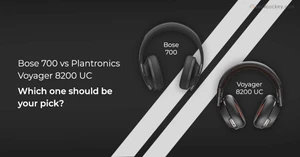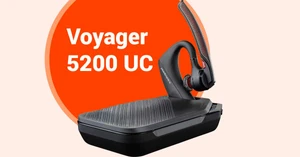What are Headphones?
A headphone is a piece of hardware that uses two small speakers that convert electrical signals to sound by vibrating surrounding air, with the help of conductive coils and magnets. They are worn over a user’s ears so that the individual can hear the audio source privately.
How to Use Bluetooth Headphones
Bluetooth headphones require the user to switch them on via the power button. An LED indicator will indicate that they are on. Now, users can connect Bluetooth headphones to any device with audio signals. These headphones utilize Bluetooth pairing technology for connecting to PC and mobile devices.
After a successful pairing, users can wear such headphones and play audio files. For the Bluetooth Headphones to work uninterruptedly, you need to charge them with the help of a power source.
Difference Between Headset and Headphone
Headsets have an attached microphone, which is not there with headphones. Headsets can have different types of microphones like in-line or removable microphones and connect to various devices like PC, laptop, mobile, PlayStation, Xbox, among others. Headphones can have a dedicated mic for control but no attachable microphone.
Bluetooth Headset with mic or any other headset allows you to receive immersive sound quality with clear mono or stereo sound. A stereo headset is common among calling executives for video calls and conferences.
Bluetooth headsets can also act as gaming headphones with microphone. Head phone with mic integration can provide stereo sound effect while gaming. Further, Bluetooth headphones with mic or any other wireless headphones with mic can be used to listen to audio files available in other devices on the go.
Latest headphones are wider and more spacious area around the ears to decrease pressure and ensure all-day comfort. Headsets are much narrower and can also be used in one ear for calling such as in single ear Bluetooth headset.
Difference Between On-ear and Over-ear Headphones
- Placement: On-ear headphones sit on the top of a user’s ears and have small earpads. Over ear headphones fit around user ears fully and have large earpads.
- Weight: On-ear headphones are designed for portable use and hence the weight of their components like battery, drivers, and microphones is lighter. Over ear headphones are heavier and contain more hardware components, though they can also be used as portable devices.
- Fitting: On-ear headphones easily fit the ears and the earpads are not constricting for the user. Over-ear headphones may or may not fit depending on the size of the user’s ears and could strain the neck.
- Noise cancellation: Both on-ear and over-ear headphones use passive noise cancellation. But over-ear headphones are usually the ones supporting active noise cancellation (ANC).
- Battery: On-ear headphones last longer than over-ear headphones which have ANC on. The batteries of over ear headphones are bigger, but ANC results in high power consumption.
- Comfort: On-ear headphones do not support ANC and users tend to increase the volume while listening, which can hurt their ears. Over-ear headphones support ANC which means users can hear clearly at lower volume for long sessions. You can use over-ear headphones for better experience without hurting your ears. Listening at a lower volume also decreases the rate of battery discharge.
- Sound Quality: On-ear headphones offer a bit lower sound quality compared to over-ear headphones, which create a better immersive environment by surrounding the ears completely.
Difference Between Wireless and Bluetooth Headphones
Bluetooth head phone comes as a category under wireless headphones. There are other types of wireless headphones like Wifi headphones.
- Technology: Wireless headphones use infrared and radio waves to transmit and receive audio signals. Blue tooth headphones depend solely on radio waves. Wireless headphones use USB adapters to connect with other devices while Bluetooth headphones get paired with a device via wireless Bluetooth technology.
- Compatibility: Wireless headphones are not compatible with as many devices as Bluetooth headphones. Blue tooth headphones can connect with most devices that support Bluetooth. Both expensive and cheap wireless headphones are usually compatible with only the same brand devices.
- Range: Best wireless headphones can work up to a range of about 90m (300 feet). Blue tooth headphones can typically be used only within a range of 7 to 9m (30 feet). However, the latest versions of best Bluetooth headphones can pick the sound up to 200 m (650 feet).
Types of Bluetooth Headphones
Bluetooth headphones & headsets are easily available in the market. There are three types of Bluetooth headphones.
- In-Ear Headphones: These are compact and small headphones, also known as Bluetooth earphones. These earphone headphones are miniature in form and sit directly into the ear with tips of the headphone pressed slightly into the canal. If you use earbuds with mic, they rest outside the ear canal on the concha. Earphones with microphone are also available. The earphones with mic offer good noise blocking and isolation for their pricing.
- On-Ear Headphones: On-ear headphones are portable and sit on the top of ears. These superaural headphones offer a more comfortable alternative to in-ear headphones, which put pressure on ears. Further, on-ear headphones are lighter than any other type of headphones. This type of headphone can also be used as a handsfree earphone for calling.
- Over Ear Headphones: These circumaural headphones sit comfortably on the top of the ears. They are present at a distance from ear canal, decreasing the chance of any form of harm. Over ear headphones can be used where hi-fidelity sound and noise cancellation are required.
What are Noise Cancelling Headphones
Noise canceling headphones implement active noise cancellation (ANC) technology along with passive method to reduce unwanted surrounding sounds.
ANC captures sounds through microphones and filters them out by using counter frequencies to significantly reduce the noise from outside environment. Passive noise isolation is the easier way to block out lower volume sounds using physical barriers, that is, padding and layers.
Noise cancelling earphones are highly effective in outdoor noisy environments when you want to listen the audio clearly. Best noise cancelling headphones can also help individuals in calming their senses while listening to music or listening to any conversation during travels.
Which Type of Headphones are Good for Ears
Noise cancellation headphones are the best headphones for ears as they block external sounds sufficiently. You don’t need to increase the volume to hear any conversation. This protects ears from loud volume and users can listen to music and conversations for a long period.























